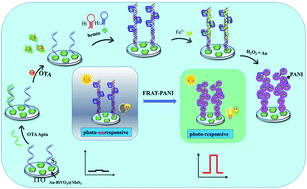Target-engineered photo-responsive DNA strands: a novel signal-on photoelectrochemical biosensing platform for ochratoxin A†
Abstract
In this study, we report a novel and efficient method for the conversion of the photo-response of DNA strands and the validation of their feasibility for use as a versatile signal-amplified system for constructing a photoelectrochemical (PEC) DNA sensor. Emeraldine polyaniline molecules could grow and enwrap the long linear DNA polymeric skeleton with the catalytic ability of the embedded Fenton reagent and DNAzyme. Indeed, the DNA backbone was converted into a photoactive matrix, which could efficiently enhance the utilization of visible light, thus basically improving the photocurrent response. Inspired by this phenomenon, using the long linear DNA polymeric skeleton, which was generated by a target-triggered hybrid chain reaction, as the template for loading ferrous ions and DNAzyme, a distinctive PEC platform was proposed based on decahedral Au–BiVO4@MoS2 as the photoactive substance. The generated PANI wire could efficiently absorb light in the visible region and produce more electrons, thus further restraining electron–hole recombination in Au–BiVO4@MoS2, endowing the DNA sensor with excellent analytical performances. Under optimal conditions, the proposed PEC assay showed excellent sensitivity for the detection of ochratoxin A with a low detection limit of 0.14 pg mL−1 and wide linear range from 0.25 pg mL−1 to 25 ng mL−1. Moreover, it presents good stability and satisfactory accuracy and is a promising methodology for the determination of multiple other targets by replacing the recognition elements.



 Please wait while we load your content...
Please wait while we load your content...